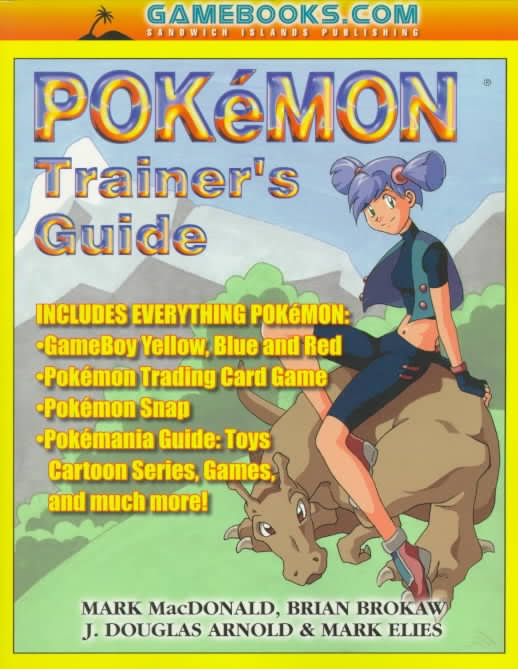

Pokémon Trainer's Guide
Publisher: Sandwich Islands Publishing, 1999
Authors: Mark MacDonald, Brian Brokaw, J. Douglas Arnold, and Mark Elies
Pages: 200
ISBN: 1-884364-25-X
Published by the late Sandwich Islands Publishing, Pokémon Trainer's Guide is a tour-de-force of everything Pokémon in late 1999. The book has six distinct sections, starting out with the TV episode guide with the original 52 or so episodes from the first season. It only has about two sentences per line and while it doesn't spoil much (very similar to how TV guides at the time summarized television episodes), it doesn't explain much, nor what plot-relevant things happened in the episodes, as even the first season was chock-full of filler (I remember a website used to have that...which I thought was Dogasu's Backpack, but if they did they don't have it now). I remember being very confused that the synopsis for "Holiday at Aopulco", the 18th episode of the anime, which was more correct than I ever thought. It's supposed to be read as "Holiday at Acapulco", but that apparently is how the kanji is translated directly, plus listing "Obaba" for "Who's That Pokémon". That was also more correct than I thought--Obaba wasn't a Pokémon, but rather a character in the episode used for a gag during the WTM segment. I had tried to write "Tentacool" in there, but that was when they re-released it in 2000 as "Beauty and the Beach" and dramatically cut down. Even as a kid I could tell it wasn't edited the same way other episodes were (this was, of course, before the handling of One Piece). The notorious 38th episode, "Electric Soldier Porygon" (with the mention of hundreds of seizures caused) is covered, but makes no mention that Episode 35, "The Legend of Dratini" was also cut from the U.S. rotation and never dubbed due to gun usage (and introduced the plothole of "Where did Ash get dozens of Tauros"). Finally, while it does mention the special "Holiday Hi-Jynx" (which is no longer available in its original form due to Jynx having to be redesigned), it does not mention the other special, "Snow Way Out!" (and certainly no mention of a canned New Years Eve-themed special episode).
Next, there's a eight-page section on some Pokémon toys (this is one of the more interesting parts as these sorts of things, especially as information on Japanese first-generation "Pocket Monsters" merchandise is hard to come by).
The meat of the guide is a full-color walkthrough with maps of the entire game, including what Pokémon you can catch and what the bosses have. The walkthrough here is very amateurish, resembling GameFAQs guides written by teenagers, and of course they can't resist a "Great Ball" joke. It does have full-color maps but they're pretty blurry. Now, of course, being amateurish doesn't mean it's wrong (for some reason, there's some zoomer conspiracy that all these books were full of lies). Sure, there's one place where a trade causes a Machoke to evolve into a Machop (it should be Machamp, but that's probably a typo) but it capitalizes and punctuates "Pokémon" correctly (some books, like a TCG book, does not). However, they didn't figure out capitals, so throughout the book there's "POKéMON" instead of the more correct "POKÉMON".
If you wanted to nitpick, they explain that the Japanese versions had Red, Blue, and Green, whereas the first American releases had only Red and Blue, they say that "Red made the trip overseas unscathed, but the Green cartridge became the U.S. Blue cartridge, and the Japanese Blue failed to make the trip". The truth is a little more complicated--the resulting "Red" and "Blue" that we got in the West are essentially all the updates of Japanese Blue but with the Pokémon availability of Red and Green, respectively (and why Red has the weirder, off-model sprites). Still, its understandable given the lack of information at the time that they came to that conclusion.
The "Pokémon Game Boy Monster Index" section lists each Pokémon with their sprite (mostly Red/Blue with the occasional Yellow sprite, so Pikachu's sprite is from Yellow, but Mew is from Red/Green, where it looks like some sort of alien fetus), the attacks they learn and can learn (though did not make any updates for Yellow, as some movesets were updated), where they're found (for Red/Blue/Yellow), and a picture of their 3D likeness from Pokémon Stadium, except for Omastar, which is listed as "Camera Shy"...so probably a joke because the original file got corrupted somehow down the line and was not able to make it to print in time.
The next big section covers the TCG (with a shout-out to the Topps cards, not exactly the Pokémon cards everyone was talking about) with some strategy, card lists (Base/Jungle/Fossil), and an advertisement for their full guidebook to the TCG itself (which also has a section on Pokémon Pinball).
A final section covers Pokémon Snap and its seven levels with brief descriptions of how to get good shots of the monsters (no maps). Being a fairly simple guidebook, it doesn't cover glitches (real or rumored), so nothing on MissingNo, nothing on the truck, nothing on getting Mew (legitimate or less legitimate), nothing on how to get in Glitch City, nothing on "PokéGods", nothing on "Pikablu", nothing on getting permanently stuck on Cinnabar Island (which is almost impossible to do accidentally), nor does it cover hidden items. (All of these are better-documented elsewhere).
As you might've guessed by that weird cow thing on the cover and the overall writing, it's obviously unofficial (hence, the "OC"mon) but given it was my first real Pokémon book and the admirable effort for covering far more than the game, I can't criticize it too harshly for its shortcomings but it's not an essential in the gamer's library.
Return to Main Page | Return to Books & Strategy Guides Index | Contact Me
(c) 2022 Carbon-izer.com